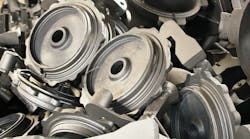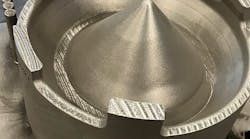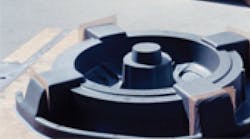While the drive to reduce operating costs may seem like a never-ending road for metalcasting operations, an organization’s ability to convert those cost-efficiencies into powerful and immediate market leverage is undeniably a deciding factor in their long-term survival. What makes this formidable task even more challenging is the acceptable “cost” of cost reductions.
Significant capital investment in new production equipment yields true savings only after the “payback” period is complete. At the same time, should a more attractive solution arise later it may be difficult for a customer to change again. Technical flexibility is an advantage few organizations actively manage well, but those who do expose themselves to the least risk.
Cleaning room or casting “finishing” operations have long been target areas for increased efficiency and cost-reduction efforts, and can represent a significant portion of total production cost. Removing runner systems and risers from a finished casting typically requires foundry personnel to use cutting saws, abrasive wheels, or cutting torches. Although effective, these techniques also expose workers to risk of injury from repetitive vibration, high noise levels, heavy lifting, and respiratory dust.
While some of the largest foundries (mostly captive OEM) have the financial ability to purchase one or more automated robotic systems to handle finishing operations, most medium-sized and smaller metalcasters continue to search for less costly options simply to remain competitive. Not surprisingly, innovative foundries that find ways to squeeze costs or make their cleaning operations more efficient tend to protect their discoveries, particularly when those methods do not require large capital expenditures and can be adopted easily.
Internal Best Practices
One of the most surprising, yet effective techniques that has been a “back-room best practice” for many foundries is using standard silica-mesh fabric in runner systems and in the base of riser sleeves to create “cleavage planes” that typically come apart during vibratory shakeout, or with the minor impact of a shop hammer. For anyone watching cleaning room personnel spend hours cutting small castings from runner trees, or witnessing a hydraulic ram violently bash risers from large castings, the value of “low-impact” de-gating is no mystery. An additional benefit of using standard silica-mesh material as a de-gating aid is that it acts as a molten metal filter wherever it’s placed. While it’s not uncommon for foundries to use ceramic foam filters placed directly in runner systems or in the bottom of riser sleeves for additional filtration, ceramic foam filters do nothing to make runner segmentation or riser-removal any easier.
No “one-size fits all”
Of course, there are certain drawbacks and limitations to using standard silica-mesh cloth that foundrymen should consider for their specific application. These considerations include:
• Molten metal temperature maximum of approximately 2,800°F/1,534°C – The application alloy pouring temperature should not exceed the recommended level as the mesh material can quickly “break-through”. Therefore, casting stainless steel or other hightemperature alloy applications must be monitored carefully to avoid temperature variations.
• Incompatibility with aluminum and pure copper – Typically, standard silica-mesh cloth is treated with a thermal setting phenolic resin and pre-shrunk to create the rigidity necessary to hold the specific shapes for foundry applications. This treatment, although necessary, also precludes it from being used with pure copper because the resin chemicals are attacked by the oxides and slag generated by melted copper and lead to a rapid structural failure, and the mesh breaks through. A different problem can occur with aluminum alloys as standard silica-mesh material will “off-gas” as the molten aluminum passes through it, often causing porosity-related defects.
• Deflection or “flexing” of material into casting body – With regard to keeping the molten alloy pouring temperature below maximum, standard silica-mesh fabric typically deflects or “flexes” (but does not break) in the direction of alloy flow. This deflection is usually an acceptable drawback, as the material remains intact as a filter and provides the cleavage plane necessary for easier runner segmentation later. However, when placed in the bottom of a riser sleeve, the silica mesh can deflect downward into the body of the casting or upward into the riser sleeve, and when “knocked off” will create a surface problem that must be machined away later. The best result is a flat cleavage plane that requires no additional re-work.
Closing the Gaps
Considering the wide-ranging benefits that could be realized in finishing/cleaning room operation by addressing the problems of standard silica-mesh fabric, Comanche Technologies has developed two new products — the CerraBreaker® and the RiserBreaker® — that leverage the technical strengths of CerraFlex®, a ceramiccoated, high-strength silica mesh filter material. Each CerraBreaker is a custom-cut piece of CerraFlex that’s placed directly in the runner system where the mold designer wants break-points. Because each CerraBreaker is also a molten metal filter, designers often place additional units earlier in the flow stream to capture slag and inclusions directly in the runner network, as well as directly at the contact area for each casting.
A RiserBreaker is a CerraBreaker that has been “framed” within a core-sand breaker core, attached to the base of any variety of risersleeve. This frame design is critical to ensure there is no deflection of the CerraFlex material in either direction of molten metal flow, while the breaker-core itself creates a smaller contact area that makes “knock-off” even easier. Each RiserBreaker-Sleeve unit is customcalculated according to customer provided, application-specific data to ensure optimal performance.
Operational cost savings
So the larger (and easily the most important) question for every foundry should be “how much will we save by using CerraBreakers or RiserBreakers in our finishing operations?” The honest answer is “it will depend …,” because the scale of cleaning or finishing room operations varies significantly from one foundry to another based on average size of castings produced, alloys cast, etc. Moreover, as these techniques are used across the metalcasting process spectrum (green sand, no-bake, permanent mold, investment casting, etc.), average cost-savings will vary as well. Ultimately, this question can be answered by your operations team, as they should be driving the cost-saving, efficiency-finding initiatives. But, the workers doing the grinding and sawing will thank you.
Jason Hitchings is the general manager of Comanche Technologies. The author gratefully acknowledges the previous research published as “Use Fabric, Breaker Cores to Cut Ductile Iron Finishing Cost,” (Modern Casting, 1999) as a reference for this article. Contact him at [email protected], or visit www.comanchetechnologies.com.












